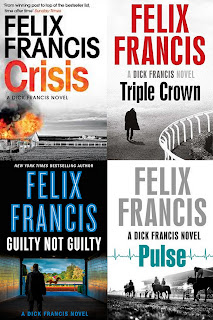I often have a couple of books 'on the go' - fiction, and nonfiction depending on how tired I am. If I'm really dozy, I like to thumb through something with pictures - but if I'm not at all sleepy, I go for something with words and a plot. Here's a quick rundown of some of the books I have read this year thus far...
Having read "Crisis" by Felix Francis before Christmas, I grabbed three more of his in January - "Guilty Not Guilty", "Triple Crown" and finally "Pulse" The first two follow the usual Francis pattern [single bloke, mid thirties, plot involving horse-racing, all sorted out in the end, everyone happy ever after except the bad guys] I'd score them both *** for sheer predictability, and sending me to sleep as desired. However Pulse does not fit the pattern - except for some horses. I won't say anymore for fear of spoilers. I felt FF wanted to write about a particular subject [possibly because it had affected his own family?] Maybe he wanted to help other people understand but I don't think it worked. If you like the Dick&Felix books, then by all means give it a try - but don't expect it to be anything like all the others! Instead of a soporific, it was an annoyance. I kept muttering "No, I don't think that's how it is!" "I think he has that bit wrong!" under the duvet, and disturbing Bob's reading. Therefore I rate it just **
Non fiction - following my visit to Textile Treasures, I borrowed "500 Simply Charming Designs for Embroidery - easy to stitch monograms and motifs" This one lived up to its title. In 6 parts - Home and Hobby, Nature's Living Things, Special Occasions, Tasty Things To Eat, Letters and Numbers, Borders and Lines.[and each part had 4 or 5 subsections] Each design was shown finished, and with a clear diagram of the stitches used. There were suggestions for how to use the designs-on cards, on homewares and clothing etc.
I'd rate this *****
"An Encyclopedia of Stitches" covers twenty two different types of embroidery -from 17th century Stumpwork, and ancient Indian Shisha mirror work, through to Tudor blackwork and Norwegian Hardanger stitching, via simple cross stitch, smocking and 16 more techniques. A wonderfully comprehensive volume, written by 8 different experts.
 For every category there is an introduction with notes on history and development. Then notes on materials needed, and clear instructions on basic stitches. Finally a project piece demonstrating the work.
For every category there is an introduction with notes on history and development. Then notes on materials needed, and clear instructions on basic stitches. Finally a project piece demonstrating the work.This was a beautiful and inspiring read.
I was introduced to shisha work in the 60s by my art teacher, and came across it a lot when I worked in Leicester. Now I understand how it is done!
But I really got this book out because in the index I spotted the words "Norwich Stitch" I learned about this stitch in the Textile Treasures Webinar. I've yet to go and see the sampler piece in the Museum of Norwich. Nobody knows where the name comes from
[some people call it Waffle stitch, although there are other stitches in
embroidery, crochet and knitting with that name] Norwich stitch is complicated but I like it, and hope to include this 'local' one in my next embroidery project. Watch this space...
I'd definitely rate this book a full ***** for the breadth of information, clear instructions and doable projects. 500 motifs is a good resource- but this encyclopedia has a wider range, and if I were actually buying a book, I'd go for this one!







My mother had a sari to which she attached a panel of the Indian mirror embroidery - at some point, we removed the panel from the sari; I still have some of the panel which has become discolored with age. I keep wondering what to do with it!
ReplyDeleteCan you mount it on a larger piece of fabric and frame it? Or perhaps incorporate it into a cover for a family photo album? Please do share a photo on your blog sometime (someone else may have a genius solution)
DeleteNever heard of that Norwich stitch, would need the diagram in view to be able to do it, although it would have been too big for the little sampler I did last year on 14 count. Look forward to seeing what you do with it
ReplyDeleteI needed the diagram and a trawl through 3 YouTube videos before I understood it properly. I think it would probably work best with tapestry wool on large gauge canvas. 14count would too fine to show the detail. It is surprisingly neat on the back of the work.
DeleteI am glad that I'm not the only one who heckles books, and I now have an almost uncontrollable urge to do some embroidery!
ReplyDeleteI hope you are able to manage your Itch To Stitch!
ReplyDeleteThanks for the review of the Stitches book. I just found a used 'very good' copy at an online book site. Have plenty of embroidery materials in my stash. The leaf on the front of the book reminds me of a trip to Benmore Botanic Garden on the Cowal peninsula last October--already giving me ideas. :)
ReplyDeleteI have just ordered a secondhand copy too!
Delete